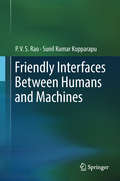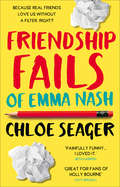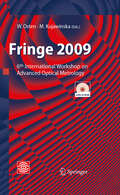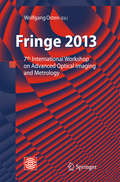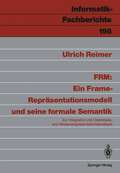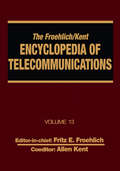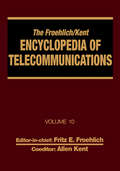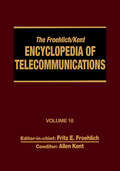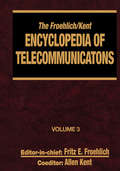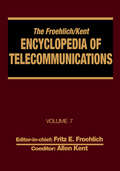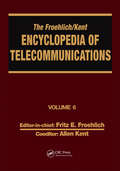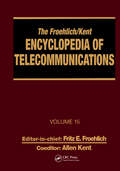- Table View
- List View
Friending the Past: The Sense of History in the Digital Age
by Alan LiuCan today’s society, increasingly captivated by a constant flow of information, share a sense of history? How did our media-making forebears balance the tension between the present and the absent, the individual and the collective, the static and the dynamic—and how do our current digital networks disrupt these same balances? Can our social media, with its fleeting nature, even be considered social at all? In Friending the Past, Alan Liu proposes fresh answers to these innovative questions of connection. He explores how we can learn from the relationship between past societies whose media forms fostered a communal and self-aware sense of history—such as prehistorical oral societies with robust storytelling cultures, or the great print works of nineteenth-century historicism—and our own instantaneous present. He concludes with a surprising look at how the sense of history exemplified in today’s JavaScript timelines compares to the temporality found in Romantic poetry. Interlaced among these inquiries, Liu shows how extensive “network archaeologies” can be constructed as novel ways of thinking about our affiliations with time and with each other. These conceptual architectures of period and age are also always media structures, scaffolded with the outlines of what we mean by history. Thinking about our own time, Liu wonders if the digital, networked future can sustain a similar sense of history.
Friending the Past: The Sense of History in the Digital Age
by Alan LiuCan today’s society, increasingly captivated by a constant flow of information, share a sense of history? How did our media-making forebears balance the tension between the present and the absent, the individual and the collective, the static and the dynamic—and how do our current digital networks disrupt these same balances? Can our social media, with its fleeting nature, even be considered social at all? In Friending the Past, Alan Liu proposes fresh answers to these innovative questions of connection. He explores how we can learn from the relationship between past societies whose media forms fostered a communal and self-aware sense of history—such as prehistorical oral societies with robust storytelling cultures, or the great print works of nineteenth-century historicism—and our own instantaneous present. He concludes with a surprising look at how the sense of history exemplified in today’s JavaScript timelines compares to the temporality found in Romantic poetry. Interlaced among these inquiries, Liu shows how extensive “network archaeologies” can be constructed as novel ways of thinking about our affiliations with time and with each other. These conceptual architectures of period and age are also always media structures, scaffolded with the outlines of what we mean by history. Thinking about our own time, Liu wonders if the digital, networked future can sustain a similar sense of history.
A Friendly Guide to Software Development: What You Should Know Without Being a Developer (Friendly Guides to Technology)
by Leticia PortellaSoftware is everywhere, but despite being so common and useful, it remains magical and mysterious to many. Still, more and more people are finding themselves working for tech companies, or with an array of software products, services, and tools. This can segregate those who understand tech from those that don’t. But it doesn’t have to be this way.This book aims to bring these two worlds closer together, allowing people to learn basic concepts of software development in a casual and straight-forward way. Assuming no previous technical knowledge, you’ll embark on a journey where you can understand and build a new software project from scratch until it is an advanced product with multiple users. A Friendly Guide to Software Development makes technical concepts broadly available and easy to understand. Imagine moving from a “traditional” company and suddenly finding yourself in one where software is the main product or is a foundational component to it. One is often left to wade through the infinite concepts while still doing their actual jobs. This book closes that gap. In doing so, you’ll be able to achieve better communication, which will undoubtedly lead to better working relationships, a better working environment, and ultimately better software.What You'll LearnSee how a new software project is createdExamine the basics of software development and architectureKnow which questions to ask to avoid potential problems and pitfallsStart using and building software projectsWho This Book Is ForThose without a traditional technical background people like business and project managers who need to work closely with software developers and teamsPeople who are interested in building a software system but don’t know where to start.Programmers who want to jump to development but have no experience in the industry and its common concepts
Friendly Interfaces Between Humans and Machines
by P. V. Rao Sunil Kumar KopparapuThis book discusses human–machine interactions, specifically focusing on making them as natural as human–human interaction. It is based on the premise that to get the right connect between human and machines, it is essential to understand not only the behavior of the person interacting with the machine, but also the limitations of the technology. Firstly, the authors review the evolution of language as a spontaneous, natural phenomenon in the overall scheme of the evolutionary development of living beings. They then go on to examine the possible approaches to understanding and representing the meaning and the common aspects of human–human and human–machine interactions, and introduce the keyconcept-keyword (also called minimal parsing) approach as a convenient and realistic way to implement usable human–machine interface (HMI) systems. For researchers looking for practical approaches, way beyond the realms of theory, this book is a must read.
Friendship Fails of Emma Nash
by Chloe SeagerEmma Nash is back….and determined to work out the world of friendships and relationships once and for all (…ish). ‘Great fun and full of laugh-out-loud moments. Perfect for fans of Holly Bourne’. Katy Birchall, author of the It Girl series
Fringe 2009: 6th International Workshop on Advanced Optical Metrology
by Wolfgang Osten Malgorzata Kujawinska21 years ago it was a joint idea with Hans Rottenkolber to organize a workshop dedicated to the discussion of the latest results in the automatic processing of fringe patterns. This idea was promoted by the insight that automatic and high precision phase measurement techniques will play a key role in all future industrial and scientific applications of optical metrology. A couple of months later more than 50 specialists from East and West met in East Berlin, the capital of the former GDR, to spend 3 days with the discussion of new principles of fringe processing. In the stimulating atmoshere the idea was born to repeat the workshop and to organize the meeting in an olympic schedule. And thus meanwhile 20 years have been passed and we have today Fringe number six. However, such a workshop takes place in a dynamic environment. Therefore the main topics of the previous events were always adapted to the most interesting subjects of the new period. In 1993 the workshop took place in Bremen and was dedicated to new principles of optical shape measurement, setup calibration, phase unwrapping and nondestructive testing, while in 1997 new approaches in multi-sensor metrology, active measurement strategies and hybrid processing technologies played a central role. 2001, the first meeting in the 21st century, was focused to optical methods for micromeasurements, hybrid measurement technologies and new sensor solutions for industrial inspection.
Fringe 2013: 7th International Workshop on Advanced Optical Imaging and Metrology
by Wolfgang OstenIn continuation of the FRINGE Workshop Series this Proceeding contains all contributions presented at the 7. International Workshop on Advanced Optical Imaging and Metrology. The FRINGE Workshop Series is dedicated to the presentation, discussion and dissemination of recent results in Optical Imaging and Metrology. Topics of particular interest for the 7. Workshop are: - New methods and tools for the generation, acquisition, processing, and evaluation of data in Optical Imaging and Metrology (digital wavefront engineering, computational imaging, model-based reconstruction, compressed sensing, inverse problems solution) - Application-driven technologies in Optical Imaging and Metrology (high-resolution, adaptive, active, robust, reliable, flexible, in-line, real-time) - High-dynamic range solutions in Optical Imaging and Metrology (from macro to nano) - Hybrid technologies in Optical Imaging and Metrology (hybrid optics, sensor and data fusion, model-based solutions, multimodality) - New optical sensors, imaging and measurement systems (integrated, miniaturized, in-line, real-time, traceable, remote) Special emphasis is put on new strategies, taking into account the active combination of physical modeling, computer aided simulation and experimental data acquisition. In particular attention is directed towards new approaches for the extension of existing resolution limits that open the gates to wide-scale metrology, ranging from macro to nano, by considering dynamic changes and using advanced optical imaging and sensor systems.
FRM: Zur Integration von Datenbank- und Wissensrepräsentationsansätzen (Informatik-Fachberichte #198)
by Ulrich ReimerDas Buch stellt FRM vor, ein Frame-basiertes Modell zur Repräsentation von Wissen. Der Schwerpunkt liegt dabei auf der Ausarbeitung der Semantik seiner Repräsentationskonstrukte. Zur formalen Spezifikation dieser Semantik werden Integritätsbedingungen formuliert, die unzulässige, in jedem Fall bedeutungslose Repräsentationsstrukturen ausschließen. Damit wird die Basis gelegt für ein Wissensverwaltungssystem, das die Einhaltung dieser Integritätsbedingungen überwacht und somit die Gewährleistung der Validität einer Wissensbasis zu einem beträchtlichen Teil übernehmen kann. Ein(e) Wissensingenieur(in), der/die insbesondere beim Aufbau großer, vernetzter Wissensbasen Schwierigkeiten hat, die Übersicht zu bewahren, kann dadurch erheblich entlastet werden, und es wird somit ein Beitrag geleistet, die bei der Erstellung großer Wissensbasen entstehende Komplexitätsbarriere aufzubrechen. Neben der Spezifikation der Repräsentationsstrukturen von FRM werden auch Anfrage- und integritätserhaltende Änderungsoperationen diskutiert, womit ein häufig in Wissensrepräsentationssprachen anzutreffendes Defizit vermieden wird. Die Darstellung schlägt eine Brücke zwischen Ansätzen aus dem Datenbankbereich und dem Bereich der Künstlichen Intelligenz (KI). So ist der Gegenstand eines Frame-Repräsentationsmodells mit seinen mächtigen Modellierungsmöglichkeiten eindeutig ein KI-Thema, während die Aspekte der Integritätserhaltung, die sich aus dem Bedarf nach einer Unterstützung großer Datenmengen ableiten, eher typisch für die Betrachtungsweise im Datenbankbereich sind. Entsprechend werden Bezüge hergestellt zwischen FRM und einschlägigen Arbeiten aus dem Datenbankbereich und der KI sowie ferner der Linguistik und der Kognitionspsychologie.
The Froehlich/Kent Encyclopedia of Telecommunications: Volume 13 - Network-Management Technologies to NYNEX
by Fritz E. Froehlich Allen KentThis article reviews network-management problems, technologies and standards, outlining the problems and challenges of the field. It overviews the functions and architectures, of various components of network-management systems (NMSs), describing key network-management application areas.
The Froehlich/Kent Encyclopedia of Telecommunications: Volume 13 - Network-Management Technologies to NYNEX
by Fritz E. Froehlich Allen KentThis article reviews network-management problems, technologies and standards, outlining the problems and challenges of the field. It overviews the functions and architectures, of various components of network-management systems (NMSs), describing key network-management application areas.
The Froehlich/Kent Encyclopedia of Telecommunications: Volume 10 - Introduction to Computer Networking to Methods for Usability Engineering in Equipment Design
by Fritz E. Froehlich Allen KentIntroduction to Computer Networking to Methods for Usability Engineering in Equipment Design.
The Froehlich/Kent Encyclopedia of Telecommunications: Volume 10 - Introduction to Computer Networking to Methods for Usability Engineering in Equipment Design
by Fritz E. Froehlich Allen KentIntroduction to Computer Networking to Methods for Usability Engineering in Equipment Design.
The Froehlich/Kent Encyclopedia of Telecommunications: Volume 18 - Wireless Multiple Access Adaptive Communications Technique to Zworykin: Vladimir Kosma
by Fritz E. Froehlich Allen KentVolume 18- Wireless Multiple Access Adaptive Communications Technique to Zworykin, Vladimir Kosma. The only continuing source that helps users analyze, plan, design, evaluate, and manage integrated telecommunications networks, systems, and services, The Froehlich/Kent Encyclopedia of Telecommunications presents both basic and technologically advanced knowledge in the field. An ideal reference source for both newcomers as well as seasoned specialists, the Encyclopedia covers seven key areas--Terminals and Interfaces; Transmission; Switching, Routing, and Flow Control; Networks and Network Control; Communications Software and Protocols; Network and system Management; and Components and Processes.
The Froehlich/Kent Encyclopedia of Telecommunications: Volume 18 - Wireless Multiple Access Adaptive Communications Technique to Zworykin: Vladimir Kosma
by Fritz E. Froehlich Allen KentVolume 18- Wireless Multiple Access Adaptive Communications Technique to Zworykin, Vladimir Kosma. The only continuing source that helps users analyze, plan, design, evaluate, and manage integrated telecommunications networks, systems, and services, The Froehlich/Kent Encyclopedia of Telecommunications presents both basic and technologically advanced knowledge in the field. An ideal reference source for both newcomers as well as seasoned specialists, the Encyclopedia covers seven key areas--Terminals and Interfaces; Transmission; Switching, Routing, and Flow Control; Networks and Network Control; Communications Software and Protocols; Network and system Management; and Components and Processes.
The Froehlich/Kent Encyclopedia of Telecommunications: Volume 3 - Codes for the Prevention of Errors to Communications Frequency Standards
by Fritz E. Froehlich Allen Kent"The only continuing source that helps users analyze, plan, design, evaluate, and manage integrated telecommunications networks, systems, and services, The Froehlich/Kent Encyclopedia of Telecommunications presents both basic and technologically advanced knowledge in the field. An ideal reference source for both newcomers as well as seasoned specialists, the Encyclopedia covers seven key areas--Terminals and Interfaces; Transmission; Switching, Routing, and Flow Control; Networks and Network Control; Communications Software and Protocols; Network and system Management; and Components and Processes."
The Froehlich/Kent Encyclopedia of Telecommunications: Volume 3 - Codes for the Prevention of Errors to Communications Frequency Standards
by Fritz E. Froehlich Allen Kent"The only continuing source that helps users analyze, plan, design, evaluate, and manage integrated telecommunications networks, systems, and services, The Froehlich/Kent Encyclopedia of Telecommunications presents both basic and technologically advanced knowledge in the field. An ideal reference source for both newcomers as well as seasoned specialists, the Encyclopedia covers seven key areas--Terminals and Interfaces; Transmission; Switching, Routing, and Flow Control; Networks and Network Control; Communications Software and Protocols; Network and system Management; and Components and Processes."
The Froehlich/Kent Encyclopedia of Telecommunications: Volume 7 - Electrical Filters: Fundamentals and System Applications to Federal Communications Commission of the United States
by Fritz E. Froehlich Allen Kent"The only continuing source that helps users analyze, plan, design, evaluate, and manage integrated telecommunications networks, systems, and services, The Froehlich/Kent Encyclopedia of Telecommunications presents both basic and technologically advanced knowledge in the field. An ideal reference source for both newcomers as well as seasoned specialists, the Encyclopedia covers seven key areas--Terminals and Interfaces; Transmission; Switching, Routing, and Flow Control; Networks and Network Control; Communications Software and Protocols; Network and system Management; and Components and Processes."
The Froehlich/Kent Encyclopedia of Telecommunications: Volume 7 - Electrical Filters: Fundamentals and System Applications to Federal Communications Commission of the United States
by Fritz E. Froehlich Allen Kent"The only continuing source that helps users analyze, plan, design, evaluate, and manage integrated telecommunications networks, systems, and services, The Froehlich/Kent Encyclopedia of Telecommunications presents both basic and technologically advanced knowledge in the field. An ideal reference source for both newcomers as well as seasoned specialists, the Encyclopedia covers seven key areas--Terminals and Interfaces; Transmission; Switching, Routing, and Flow Control; Networks and Network Control; Communications Software and Protocols; Network and system Management; and Components and Processes."
The Froehlich/Kent Encyclopedia of Telecommunications: Volume 6 - Digital Microwave Link Design to Electrical Filters
by Fritz E. Froehlich Allen Kent"The only continuing source that helps users analyze, plan, design, evaluate, and manage integrated telecommunications networks, systems, and services, The Froehlich/Kent Encyclopedia of Telecommunications presents both basic and technologically advanced knowledge in the field. An ideal reference source for both newcomers as well as seasoned specialists, the Encyclopedia covers seven key areas--Terminals and Interfaces; Transmission; Switching, Routing, and Flow Control; Networks and Network Control; Communications Software and Protocols; Network and system Management; and Components and Processes."
The Froehlich/Kent Encyclopedia of Telecommunications: Volume 6 - Digital Microwave Link Design to Electrical Filters
by Fritz E. Froehlich Allen Kent"The only continuing source that helps users analyze, plan, design, evaluate, and manage integrated telecommunications networks, systems, and services, The Froehlich/Kent Encyclopedia of Telecommunications presents both basic and technologically advanced knowledge in the field. An ideal reference source for both newcomers as well as seasoned specialists, the Encyclopedia covers seven key areas--Terminals and Interfaces; Transmission; Switching, Routing, and Flow Control; Networks and Network Control; Communications Software and Protocols; Network and system Management; and Components and Processes."
The Froehlich/Kent Encyclopedia of Telecommunications: Volume 17 - Television Technology
by Fritz E. Froehlich Allen KentVolume 17- Television Technology to Wire Antennas. The only continuing source that helps users analyze, plan, design, evaluate, and manage integrated telecommunications networks, systems, and services, The Froehlich/Kent Encyclopedia of Telecommunications presents both basic and technologically advanced knowledge in the field. An ideal reference source for both newcomers as well as seasoned specialists, the Encyclopedia covers seven key areas--Terminals and Interfaces; Transmission; Switching, Routing, and Flow Control; Networks and Network Control; Communications Software and Protocols; Network and system Management; and Components and Processes.
The Froehlich/Kent Encyclopedia of Telecommunications: Volume 17 - Television Technology
by Fritz E. Froehlich Allen KentVolume 17- Television Technology to Wire Antennas. The only continuing source that helps users analyze, plan, design, evaluate, and manage integrated telecommunications networks, systems, and services, The Froehlich/Kent Encyclopedia of Telecommunications presents both basic and technologically advanced knowledge in the field. An ideal reference source for both newcomers as well as seasoned specialists, the Encyclopedia covers seven key areas--Terminals and Interfaces; Transmission; Switching, Routing, and Flow Control; Networks and Network Control; Communications Software and Protocols; Network and system Management; and Components and Processes.
The Froehlich/Kent Encyclopedia of Telecommunications: Volume 15 - Radio Astronomy to Submarine Cable Systems
by Fritz E. Froehlich Allen KentThis is volume fifteen of the Encyclopedia of Telecommunications, which covers Radio Astronomy to Submarine Cable Systems in alphabetical listing and information on the contributors
The Froehlich/Kent Encyclopedia of Telecommunications: Volume 15 - Radio Astronomy to Submarine Cable Systems
by Fritz E. Froehlich Allen KentThis is volume fifteen of the Encyclopedia of Telecommunications, which covers Radio Astronomy to Submarine Cable Systems in alphabetical listing and information on the contributors
Frog and Toad are Doing Their Best [A Parody]: Bedtime Stories for Trying Times
by Jennie EgerdieAt home, work, and out in our ever-changing world, we're all just doing our best. In this modern parody, Frog and Toad are here to commiserate and lend some laughter.Full of wry humor and deep compassion for our modern vulnerabilities, the stories in Frog and Toad Are Doing Their Best perfectly capture the heartwarming authenticity of Lobel&’s famous amphibian friends while revealing razor-sharp truths about the world we live in today. Through Frog and Toad, we see the anxieties that are woven throughout our everyday existence, from our well-meaning but often-failed attempts at practicing self-care to our struggle to balance the gifts and burdens of technology. Toad ponders a variety of questionable schemes to pay off his credit cards, while Frog spends too much time scrolling through the newsfeed on his phone. But despite their daily frustrations and existential concerns, they know that having a friend to share life&’s burdens makes even the darkest days brighter.


